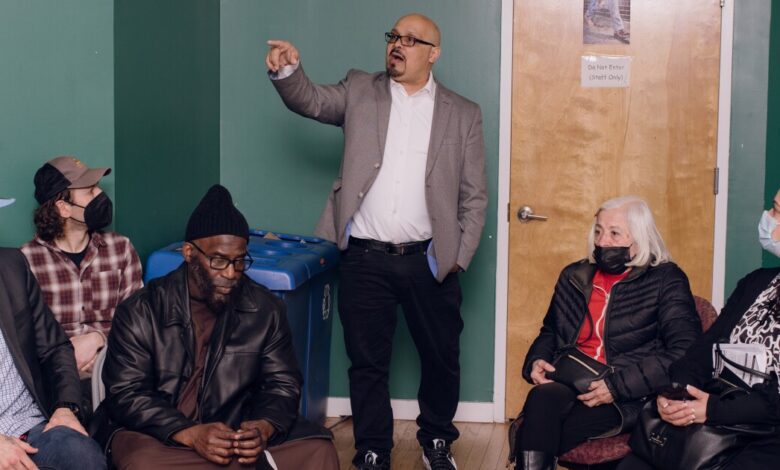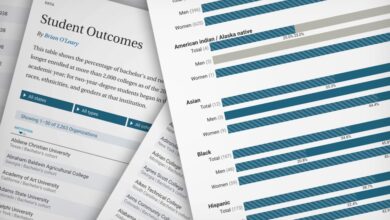With Restoration of Pell, More Students Will Leave Prison with College Credit. Are Colleges Ready?

[ad_1]
When Ortiz maxed out of prison 30 years later, in 2016, he entered a world of smart phones and social media. He had no ID, no birth certificate, and nowhere to go but to his mother’s home in public housing, where he had to remain indoors, away from windows, because his mother worried she’d be evicted for housing a felon. It was, he recalled, “worse than prison.”
Earlier that year, Ortiz had been part of the first cohort at Northern State Prison to earn associate degrees through a collaboration between New Jersey colleges and the state Department of Corrections and Parole Board. He and the other graduates paraded through the prison yard while their fellow inmates applauded.
Now, he hoped to get his bachelor’s on the outside — an achievement that would require him to overcome a host of technological and psychological challenges. But first, he needed stable housing.
Since 2015, more than 22,000 incarcerated people have taken college courses through a federal experiment that has offered Pell Grants to inmates in select programs. Thousands more will become eligible for the grants this summer, when a law lifting a 1994 ban on awarding Pell funds to prisoners takes effect. That expansion is expected to lead to a boom in the number of colleges offering prison-education programs, and the number of students participating in them.
Like Ortiz, many of these students will leave prison with the drive and talent to continue their education on campus, as regular students. For colleges, their arrival will be an opportunity to expand enrollment, diversify their student bodies, and serve their social-justice missions.

Bryan Thomas for The Chronicle
There are clear links between education and recidivism, with college graduates far less likely to return to prison than those without degrees. Completing college, post-incarceration, correlates with higher wages and lower unemployment rates.
Yet a majority of prison-ed programs aren’t doing much to support their students when they get out. Of the 374 prison-ed programs surveyed by the Alliance for Higher Education in Prison in the 2019-20 academic year, less than one in five offered direct pathways to a campus program, and even fewer — 14 percent — provided re-entry services. Among those that did, the most common supports were admission and financial-aid counseling, a 2021 report by the Alliance showed. Fewer than 20 percent offered technology or housing support.
Some advocates worry that without more robust supports from colleges, many formerly incarcerated students won’t finish their degrees, blunting the impact of the Pell restoration. They argue that colleges’ duty to these students doesn’t end at the prison gate.
“Higher education in prison is the start of a lot of people’s academic journey, but it shouldn’t be the end,” said Mary Gould, a former director of the alliance. “There is a real responsibility for colleges and universities to be clear on that.”
Under new rules that take effect July 1, programs seeking to award Pell Grants in prison will need to show that they provide academic and career advising to incarcerated students that are “substantially similar” to those offered to other students, both in the prison, and upon release. They’ll also need to demonstrate that formerly incarcerated students can fully transfer their credits to any campus of the college that offers the program they were enrolled in. But they still won’t be required to provide re-entry services.
Romarilyn Ralston, who runs one of the oldest support programs for formerly incarcerated students, Project Rebound, said she’s been hearing from a growing number colleges seeking to “build that bridge” to on-campus learning. But relatively few have followed through. She thinks they’re worried about “opening the door” to trouble.
Historically, colleges that had programs tried to fly under the radar, worried about the optics of welcoming formerly incarcerated people on campus, Gould said.
“It was, Let’s not draw any attention, let’s not make any noise,” she said. Now, with all the attention being paid to the Pell restoration, “that’s really hard to do.”
People on parole may also have travel restrictions that prevent them from attending college in another county or too many miles from home.
Other would-be students are priced out of college. In prison, most students pay little or nothing for their courses, which are subsidized by the college or the state. But once they’re released, they’re expected to pay regular tuition.
Still others are derailed by admissions forms that ask applicants to check a box if they have a criminal history. Research shows the question sows fear and confusion among people who were formerly incarcerated, discouraging them from completing an application.

Bryan Thomas for The Chronicle
But the biggest barrier for many students is housing, advocates and students said. Some states won’t admit convicted felons into public housing, and some colleges don’t allow them in dorms. Many landlords are reluctant to rent to them, too. As a group, formerly incarcerated people are 10 times as likely as members of the general public to be homeless.
“It’s easier to get a job than it is to get a residence in your name if you have a felony,” said Brandon Warren, director of re-entry services at Lee College Huntsville Center, in Texas. “I’ve been out 18 years now, and I have a doctoral degree, but none of that matters to an apartment manager. All they see is that 27 years ago, I had a felony.”
Ortiz got lucky. The program that provided his prison courses, New Jersey Scholarship and Transformative Education in Prisons (NJ-STEP), offers wraparound support to students seeking to finish their degrees, or earn new ones, when they get out. In 2017, NJ-STEP’s Mountainview Communities project awarded Ortiz a scholarship and a spot in the honors dorm at Rutgers University at Newark. After a year of bouncing among his mother’s, his sister’s, and his girlfriend’s homes, Ortiz finally had the stability he needed to focus on his studies.
But dorms aren’t always ideal homes for people who’ve been in prison. Students who are out on parole may find visits from parole officers awkward, and older students may feel out of place among younger, traditional ones, said Ralston, the executive director of Project Rebound, a support program that started at San Francisco State University in the 1960s and has spread to 15 California State University campuses.
Living amid young partiers can also be risky: If campus security officers find drugs in a formerly incarcerated student’s room, that student could be cited for a parole violation, even if the drugs belonged to a roommate.
Students living in “halfway houses” confront other challenges, including strict curfews and check-in requirements. If they stay too late working on a group project, or miss a check-in while chatting with a professor, they risk a return to prison.
In New Jersey, many halfway houses lack internet access and prohibit cellphones, so students who live in them have to squeeze all their homework and group projects into however many hours they’re allowed to be on campus.

Bryan Thomas for The Chronicle
Typically, halfway-house staff members want students to return as soon as their classes end, said Regina Diamond-Rodriguez, director of transitions for NJ-STEP. She tells them it’s crucial that students stay all day, so they can take advantage of everything that happens outside class — things like office hours, career fairs, and community events.
“All the networking that happens on campus is especially important for students who don’t have the same social capital as traditional students,” said Diamond-Rodriguez. “Our students want to absorb it all.”
“Their priority is safety and our priority is education. We have to find a way to meet in the middle.”
“We’re hungry,” explained Ortiz. “We know not everything is handed to us.”
Ortiz arrived at Rutgers determined not to squander the opportunity he’d earned. Still, he struggled with self-doubt, wondering if, as a 50-year old, he could keep up with the 20-somethings.
“I didn’t have the confidence kids have,” he said. “And I thought they were smarter.”
Technology was another challenge: Learning-management systems, Microsoft Word, and Excel confounded him. Figuring them out took more time than the assignments themselves, he said.
Feelings of “impostor syndrome” are common among formerly incarcerated students, said Ralston, who has to remind her students that they deserve to be at Cal State. While Project Rebound might have eased the way — securing an extension on an application deadline, or persuading a parole officer to permit travel to campus — “they made the grades themselves.”
“This is not a handout,” she tells them. “You have the brains, you earned your spot.”
Coming to a college campus after prison can be a culture shock, said Diamond-Rodriguez. After years of being told to “mind your business” and “keep your head down,” it can be disorienting to hear, “Come join us,” she said.
Along with acculturation, formerly incarcerated students often need help navigating the academic ecosystem. In prison, their course options were limited, and materials were provided by professors. Prison staff or volunteers helped them fill out the Free Application for Federal Student Aid, or Fafsa. Most never had to apply for financial aid on their own, choose from among hundreds of courses, or order textbooks for their classes.
To build their confidence and increase their sense of belonging, college-support programs often hire staff who have served time themselves.
“Inside prison, the messaging you get is that ‘you’ll never amount to anything,’” said Ralston, who spent 23 years in prison and took her first college course there. “It takes someone with similar lived experience to help you get free of all that garbage.”
Diamond-Rodriguez, who was incarcerated for five years, believes that her background gives her some credibility with her students. Even so, “I’m still part of an institution and can be seen as someone in authority.”

Bryan Thomas for The Chronicle
And convincing students with a deep distrust of authority that the college is there to help them can be difficult, program directors say.
“We explain that there’s this whole group of people who are paid 40 hours a week to help them, and they have a hard time understanding that, because everyone they’ve encountered for the past 30 years has been paid by the state to push them down,” said David Zuckerman, acting director of the Transforming Outcomes Project at Sacramento State University.
At Rutgers Newark, formerly incarcerated students said they know Diamond-Rodriguez and other Mountainview staff care about their success. But they’re not so sure about the institution.
“I’ve never trusted any institution — it doesn’t matter what name you put behind it,” said Sammy Quiles in a recent meeting of the Mountainview seminar, a required three-credit course. “An institution is a cop waiting to whip my ass.”
“Rather than create an institutional structure and say, ‘Fit into it,’ we’re working with students to generate solutions collectively, said Chris Agans, executive director of NJ-STEP. “The class is a space for them to think about what they need, and tell us what that is.”
In some states, most notably California, formerly incarcerated students have mobilized to call attention to those needs and push for policy changes on campus and in the legislature. For students who feel out of place among traditional undergraduates, the groups provide comfort and community, said Azadeh Zohrabi, executive director of Berkeley Underground Scholars, a support program that grew out of a student-led group that started a decade ago.
“Some blend in, but some are older, with lots of tattoos,” said Zohrabi. “A lot get asked to show their ID cards, to prove they’re students.”
Rutgers doesn’t have a student-run group currently — Agans said they come and go — but its seminar creates a cohort, and a place where students can share their stories of stigma and process the politics of disclosure.
“Some people aren’t ready for the idea of second chances,” says Christopher (Talib) Charriez, the Mountainview counselor for the Newark campus. As a student at Rutgers, he practiced what he calls “strategic disclosure,” telling liberal-minded professors that he’d been in prison but keeping quiet around his younger peers. In class, he hesitated every time he raised his hand, worried not “about giving the wrong answer, but about giving a window into my past.”
Efren Mercado said he shares his history of incarceration on a “need to know basis.” Until recently, when he was in places that called for a cellphone, he’d sometimes lie and say he left his in the office, to avoid explaining that he wasn’t allowed one at the halfway house where he was living. But sometimes, fellow students wanted to do a group chat, or work on a project virtually over the weekend, when he didn’t have internet access. In those cases, he was “forced to disclose,” he said.

Bryan Thomas for The Chronicle
Mercado said he never tells professors about his past, not wanting to be treated differently from other students.
Discussion in the seminar is animated and lively, the students more vocal than the typical undergraduate. In a recent class, students discussed two texts: an article on redemption in America, and a white paper on how colleges can remove barriers to enrollment for formerly incarcerated people.
Diamond-Rodriguez began by asking the students what they took from the article, titled “The End of Second Acts?”
Sammy Quiles said it bothered him that the authors chose to highlight the plight of a low-level offender who is white. Most of the students in the class are Black or Latino, and several committed violent crimes.
“We’ve seen progress, but there’s still a taboo connected to violent offenders,” he argued.
Dwayne Knight, who admitted at the start of class that he hadn’t done the readings — he’s working two and a half jobs to cover rent and didn’t have time — surmised that the authors picked the white guy because “it’s easier to sell to the larger society.”
“Maybe redemption is reserved for the select few,” said Quiles. “I’m exceptional because of higher education, but before that, I was a high-school dropout.”
“What happens to the unexceptional?” he wondered. “I’m not ok with leaving my comrades behind, because I know what ‘sink or swim’ looks like.”
Diamond-Rodriguez asked them about the white paper, on the role of universities. A student named Base, whose last name is being withheld because he lives in a halfway house and is not authorized to speak to the news media, suggested that colleges help students apply for food stamps before they’re released, noting that “if I can’t put food on the table, the rage will return.”
Formerly incarcerated students “can have the will and the drive, but you need to have resources in place,” said a student named Kabir, who also lives in a halfway house. “A lot of people in prison have changed and don’t want to go back to their old lives.”
When he was 20, he was the getaway driver in an armed robbery gone wrong and was sentenced to 30 years for felony murder. Today, with the help of Mountainview Communities, he’s a college graduate — magna cum laude — and a leader in Newark’s robust re-entry network. He helps other ex-offenders set a fresh course for their lives, reminding them, as he did at a recent meeting of the Returning Citizens Support Group he started with his brother, that “the prison path doesn’t define you.”
“Once you come home, you need to define yourself,” he said.
Ortiz’s desire to “give back” and “help others avoid my mistakes” is extremely common among formerly incarcerated students, Agans said. By helping them find internships, jobs, and research opportunities in the field, the program is able to retain students “who otherwise drop out to take on these jobs and activities which feel urgent to them.”

Bryan Thomas for The Chronicle
Still, enrolling in college right out of prison isn’t right for everyone, Agans and other program directors said. Some students need time to sort out housing, child care and work — and re-acclimate to freedom — first.
“In prison, decisions are made for you — where to sleep, what to eat — it’s very prescribed,” said Pat Seibert-Love, policy associate for corrections education in Washington State. “It takes time to get your feet under you.”
Agans argues that colleges should pay less attention to traditional measures of academic success, like GPA and on-time graduation, when it comes to formerly incarcerated students. He doesn’t care how quickly they progress, or if their C average brings down the median.
“One of our best students took 10 years to get a degree,” he said. “We didn’t care, but he is a failure in the traditional model. It took him too long, and cost too much. But by our measures, he’s an ultimate success.”
After the support group meeting, two participants who were part of the NJ-STEP program in prison approached Agans to say they were embarrassed to have “fallen off” and wanted to visit campus. He told them they were welcome when they were ready.
Now, with thousands of people with college credit set to leave prison in the coming years, the question is: Will colleges be ready when they are?
[ad_2]
Source link






